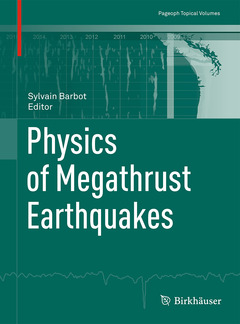Description
Physics of Megathrust Earthquakes, 1st ed. 2020
Pageoph Topical Volumes Series
Coordinator: Barbot Sylvain
Language: English
Subject for Physics of Megathrust Earthquakes:
256 p. · 19.3x26 cm · Paperback
Description
/li>Contents
/li>Biography
/li>Comment
/li>
This topical volume on the physics of megathrust earthquakes investigates many aspects of the earthquake phenomenon, from the geodynamic setting of subduction zones, to interseismic and postseismic deformation, slow-slip events, dynamic rupture, and tsunami generation.
Previously published in Pure and Applied Geophysics, Volume 176, Issue 9, 2019
The chapters ?Interseismic Coupling and Slow Slip Events on the Cascadia Megathrust?, ?Effect of Slip-Weakening Distance on Seismic?Aseismic Slip Patterns?, ?Physics-Based Scenario of Earthquake Cycles on the Ventura Thrust System, California: The Effect of Variable Friction and Fault Geometry?, and ?A Secondary Zone of Uplift Due to Megathrust Earthquakes? are available as open access articles under a CC BY 4.0 license at link.springer.com
Sylvain Barbot is an Assistant Professor at the University of Southern California, Los Angeles, USA, where he conducts research on lithosphere dynamics and the seismic cycle. His current research interests include the micromechanics of friction, the rheology of plastic flow, and crustal deformation. He uses numerical simulations to explain geodetic observations, seismological data, and laboratory measurements. His long-term goal is to understand the mechanics of rock deformation at various time and length scales to explain the earthquake phenomenon.
Provides unique insights into subduction-zone earthquakes from geology, rock mechanics, and numerical simulations
Contains a rich analysis of the mechanics of the seismic cycle at subduction zones
Contains complementary studies on the various periods of the seismic cycle, including creep, slow and fast earthquakes, and postseismic deformation
Gathers new insights into megathrust earthquakes from a combination of observation and numerical simulations
Provides new analysis of deformation before, during, and after giant earthquakes

